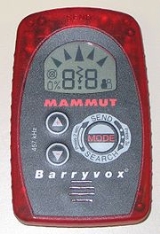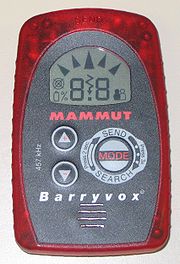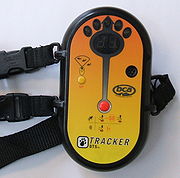
Avalanche transceiver
Encyclopedia
Avalanche transceivers are a class of radio transceiver
s specialized to the purpose of finding people or equipment buried under snow
. They are variously called Trackers, Pieps, or Arva's in a reference to some of the popular brands, "avalanche beacons" or "avalanche transceivers" - with many regional slang terms in effect. When transmitting, the device emits a pulsed signal which another transceiver can receive. Due to the nature of the radio pulse, a person holding the receiving beacon can orient it, and home in on the location of the transmitting beacon using techniques similar to radio direction finding.
Early avalanche beacons transmitted at 2.275 kHz (2275 Hz/Hertz
). In 1986 the international standard of 457 kHz, a higher radio frequency, was adopted and remains the standard today. Many companies manufacture beacons that comply with this standard.
An avalanche beacon is not considered a preventative measure for possible avalanche burial, but rather it is a way to reduce the amount of time buried.
in Buffalo, New York
, with the first units being sold in 1971 under the “Skadi” brand name. This unit, functioning on 2.275 kHz, converted the radio frequency to a simple audible tone that a human can hear. By following the tone to where it was louder, the beacon operator could use it to locate the buried beacon by using a grid searching technique.
In 1986 IKAR adopted the frequency of 457 kHz. In 1996 ASTM adopted the 457 kHz standard.

 There are two types of avalanche beacons: digital and analog. They both adhere to the international standard as described above, and only differ in the method(s) used to indicate to the user where the buried beacon is located.
There are two types of avalanche beacons: digital and analog. They both adhere to the international standard as described above, and only differ in the method(s) used to indicate to the user where the buried beacon is located.
The burial of a single beacon may involve search using one of several methods:
These search methods are adapted and extrapolated to scenarios where there is more than one burial.
Transceiver
A transceiver is a device comprising both a transmitter and a receiver which are combined and share common circuitry or a single housing. When no circuitry is common between transmit and receive functions, the device is a transmitter-receiver. The term originated in the early 1920s...
s specialized to the purpose of finding people or equipment buried under snow
Snow
Snow is a form of precipitation within the Earth's atmosphere in the form of crystalline water ice, consisting of a multitude of snowflakes that fall from clouds. Since snow is composed of small ice particles, it is a granular material. It has an open and therefore soft structure, unless packed by...
. They are variously called Trackers, Pieps, or Arva's in a reference to some of the popular brands, "avalanche beacons" or "avalanche transceivers" - with many regional slang terms in effect. When transmitting, the device emits a pulsed signal which another transceiver can receive. Due to the nature of the radio pulse, a person holding the receiving beacon can orient it, and home in on the location of the transmitting beacon using techniques similar to radio direction finding.
Early avalanche beacons transmitted at 2.275 kHz (2275 Hz/Hertz
Hertz
The hertz is the SI unit of frequency defined as the number of cycles per second of a periodic phenomenon. One of its most common uses is the description of the sine wave, particularly those used in radio and audio applications....
). In 1986 the international standard of 457 kHz, a higher radio frequency, was adopted and remains the standard today. Many companies manufacture beacons that comply with this standard.
An avalanche beacon is not considered a preventative measure for possible avalanche burial, but rather it is a way to reduce the amount of time buried.
History
In 1968 Dr. John Lawton invented the first avalanche effective transceiver in 1968 at Cornell Aeronautical LaboratoryCornell Aeronautical Laboratory
Calspan Corporation is a science and technology company originally founded in 1943 as part of the Research Laboratory of the Curtiss-Wright Airplane Division at Buffalo, New York. Calspan consists of 5 divisions: Flight Research, Transonic Wind Tunnel, Systems Engineering, Transportation Sciences...
in Buffalo, New York
Buffalo, New York
Buffalo is the second most populous city in the state of New York, after New York City. Located in Western New York on the eastern shores of Lake Erie and at the head of the Niagara River across from Fort Erie, Ontario, Buffalo is the seat of Erie County and the principal city of the...
, with the first units being sold in 1971 under the “Skadi” brand name. This unit, functioning on 2.275 kHz, converted the radio frequency to a simple audible tone that a human can hear. By following the tone to where it was louder, the beacon operator could use it to locate the buried beacon by using a grid searching technique.
In 1986 IKAR adopted the frequency of 457 kHz. In 1996 ASTM adopted the 457 kHz standard.
- 457 kHz
- 200 hours transmitting at +10C
- 1 hours receiving at -10C
- operation from -20C to +45C
- carrier keying (pulse period) 1000 ms +/- 300ms
- frequency tolerance +/-80 Hz
Types of beacons

Analog
The original avalanche beacon was an analog beacon which transmitted the pulsed signal as an audible tone to the user. The tone gets louder when the user is closer to the transmitting beacon. These beacons have also been augmented with LEDs that provide a visual indication of signal strength, and earpieces to increase the ability of the listener to hear the tone.Digital
Digital beacons take the strength of the signal and the emitted dipole flux pattern and compute distance and direction to the buried transceiverSearch techniques
Due to the highly directional nature of the 457 kHz signal at the ranges common for avalanche burial (and the range specified in the standards), there have been many techniques developed to search for buried beacons. Good beacon search abilities are considered a required skill for recreational backcountry skiers, mountaineers as well as avalanche professionals such as ski guides, ski patrollers, search and rescue volunteers and professionals. Recreationalists and professionals alike take part in drills, practice and scenarios as a regular part of avalanche skills training.The burial of a single beacon may involve search using one of several methods:
- grid searchGrid searchIn the context of machine learning, grid search is an algorithm that performs an exhaustive search through the parameter space of a learning algorithm to solve problem of model selection: finding the optimal parameters for a dataset...
- induction search
- circle method
These search methods are adapted and extrapolated to scenarios where there is more than one burial.

